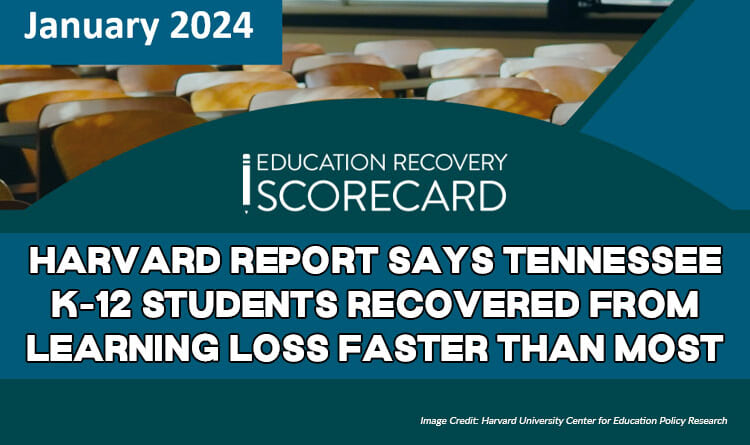Image Credit: Harvard University Center for Education Policy Research
The Center Square [By Jon Styf] –
Tennessee saw some of the largest learning recovery from pandemic conditions, according to a study from the Harvard Center for Education Policy Research.
The state saw achievement fall 50% of a grade equivalent in math and 39% in reading from 2019 to 2022.
Students in Shelby, Davidson and Montgomery saw losses of a three-quarters of a grade equivalent in math during that same stretch.
But the state’s recovery from 2022 to 2023 ranked behind just Mississippi and Pennsylvania in math and Illinois, Wisconsin, Ohio and Mississippi in reading.
“Tennessee has been a leader since the beginning of the pandemic,” according to Thomas Kane, Faculty Director of the Center for Education Policy Research at Harvard University and one of the study’s co-authors. “Now is the time to finish the job and ensure all schools soon surpass 2019 levels of achievement.”
The numbers are part of the group’s national Education Recovery Scorecard.
Tennessee began much of its learning loss recovery in January 2022.
The research says students in Collierville, Wilson, Blount and Sullivan are near or above 2019 achievement levels in both math and reading. Shelby, Montgomery, Tipton and Williamson counties remain half a grade level behind prior achievement in math.
Alabama was the only state that returned to pre-pandemic levels in math by 2023.
Students recovered one-third of the math learning loss and one quarter in reading nationwide, the research said.
Federal recovery funding has been a large factor in the efforts with $3.8 billion in federal recovery funding spent in Tennessee and $1 billion more remaining as of January.
There was $190 billion in federal funds granted to K-12 schools nationwide with $51 billion remaining that must be obligated by September.
“Once the federal dollars are depleted, however, state and local leaders may need to complete the final leg of the recovery with their own resources. Rather than continue to provide unrestricted dollars to districts, states might consider targeted incentives to districts to add instructional time by extending the school year or expanding summer learning, as Texas has done,” the report says.

About the Author: Jon Styf, The Center Square Staff Reporter – Jon Styf is an award-winning editor and reporter who has worked in Illinois, Texas, Wisconsin, Florida and Michigan in local newsrooms over the past 20 years, working for Shaw Media, Hearst and several other companies. Follow Jon on Twitter @JonStyf.



